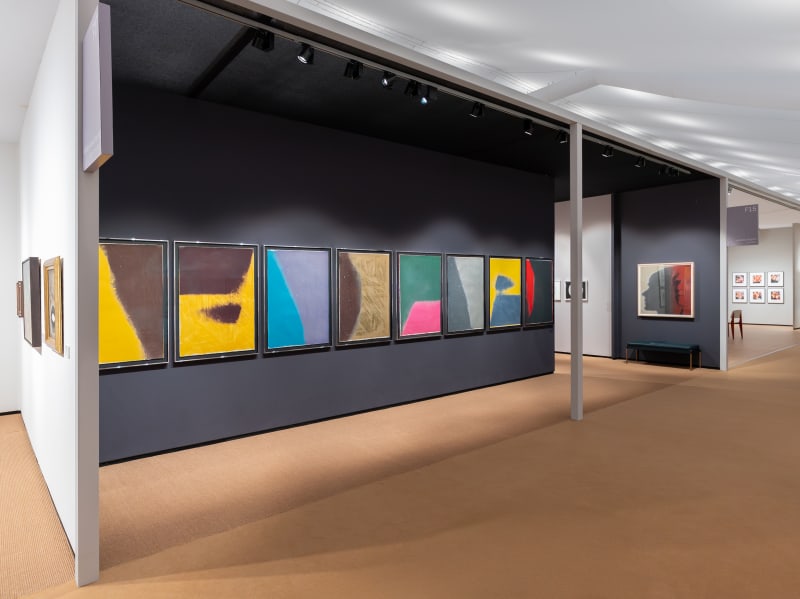Booth F15
Lyndsey Ingram is delighted to present an exceptional booth of paintings, prints and works on paper for Frieze Masters 2025. This is the gallery’s sixth year participating at the fair and on this occasion, the booth focuses on the graphic work of Andy Warhol; putting into conversation this seminal American artist’s early illustrative work from the 1950s with his later series of abstract Shadows from the 1970s and 80s.
Created in the final decade of his life, Andy Warhol’s iconic Shadows are the artist’s most abstract body of work. Whilst marking a departure from his well known depictions of cultural icons and commodity symbols, Warhol’s Shadows reflect his enduring interest in seriality and repetition. As outlined by the artist in 1979, the series is “based on a photo of a shadow in my office. It’s a silkscreen that I mop over with paint”. Warhol’s unique process imbues these works with a painterly gesture which transforms an ephemeral haze into something intangible yet deeply evocative of light, mood and space. Taking inspiration directly from his inside his studio, the Shadows are also rare examples of Warhol referring to his own source material in the production of his work.
In contrast to the Shadows, our booth also includes a selection of illustrative works on paper from Warhol’s early career. These pieces, the majority of which originate from the Andy Warhol Foundation for the Visual Arts, were created as a part of a series of handmade books the artist gifted to friends and prospective clients whilst establishing a name for himself in New York. Between 1952 and 1960, Warhol published eight manuscripts including ‘25 Cats Name(d) Sam and One Blue Pussy’, ‘À la recherche du temps perdu’, the ‘Wild Raspberries’ and ‘A Gold Book at Christmas’. These were based on drawings Warhol created with a blotted-line technique, using black ink on a piece of paper which could act as a transfer to another sheet. Warhol would hand colour the original and later invite friends to his home or the Upper East Side café Serendipity where he would host ‘colouring parties’ to paint the remaining illustrations. The painting therefore differs between each drawing, however, Warhol welcomed imperfections often collating the books into random orders and sometimes missing out pages entirely.
This is a unique opportunity to view two distinct phases of Warhol’s career as we focus on the artist’s prolific and diverse oeuvre. Centring the delicate language of his early illustrations with the broad abstract strokes of those at the end of his career our presentation delineates between two crucial elements of Warhol’s practice: his use colour and his focus on line.
Created in the final decade of his life, Andy Warhol’s iconic Shadows are the artist’s most abstract body of work. Whilst marking a departure from his well known depictions of cultural icons and commodity symbols, Warhol’s Shadows reflect his enduring interest in seriality and repetition. As outlined by the artist in 1979, the series is “based on a photo of a shadow in my office. It’s a silkscreen that I mop over with paint”. Warhol’s unique process imbues these works with a painterly gesture which transforms an ephemeral haze into something intangible yet deeply evocative of light, mood and space. Taking inspiration directly from his inside his studio, the Shadows are also rare examples of Warhol referring to his own source material in the production of his work.
In contrast to the Shadows, our booth also includes a selection of illustrative works on paper from Warhol’s early career. These pieces, the majority of which originate from the Andy Warhol Foundation for the Visual Arts, were created as a part of a series of handmade books the artist gifted to friends and prospective clients whilst establishing a name for himself in New York. Between 1952 and 1960, Warhol published eight manuscripts including ‘25 Cats Name(d) Sam and One Blue Pussy’, ‘À la recherche du temps perdu’, the ‘Wild Raspberries’ and ‘A Gold Book at Christmas’. These were based on drawings Warhol created with a blotted-line technique, using black ink on a piece of paper which could act as a transfer to another sheet. Warhol would hand colour the original and later invite friends to his home or the Upper East Side café Serendipity where he would host ‘colouring parties’ to paint the remaining illustrations. The painting therefore differs between each drawing, however, Warhol welcomed imperfections often collating the books into random orders and sometimes missing out pages entirely.
This is a unique opportunity to view two distinct phases of Warhol’s career as we focus on the artist’s prolific and diverse oeuvre. Centring the delicate language of his early illustrations with the broad abstract strokes of those at the end of his career our presentation delineates between two crucial elements of Warhol’s practice: his use colour and his focus on line.
